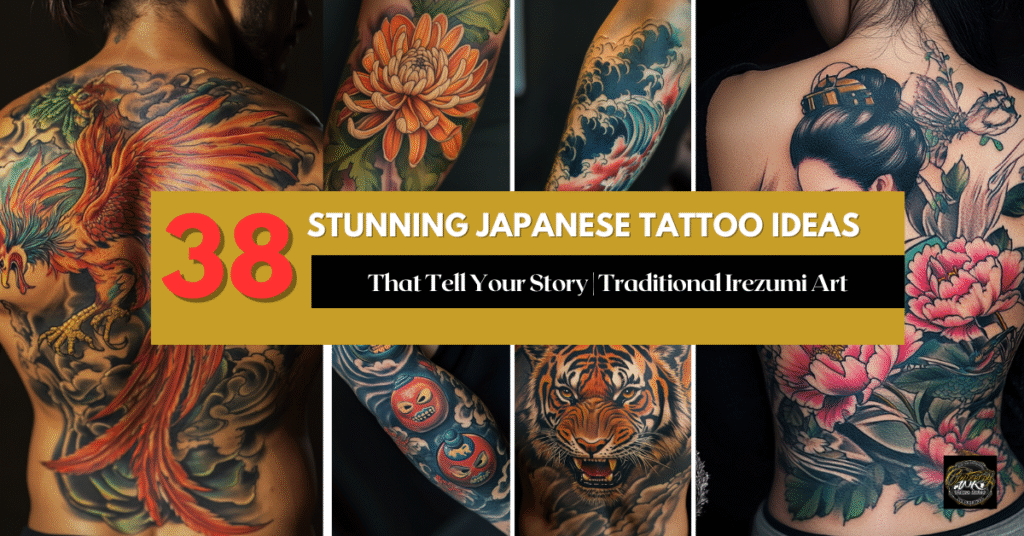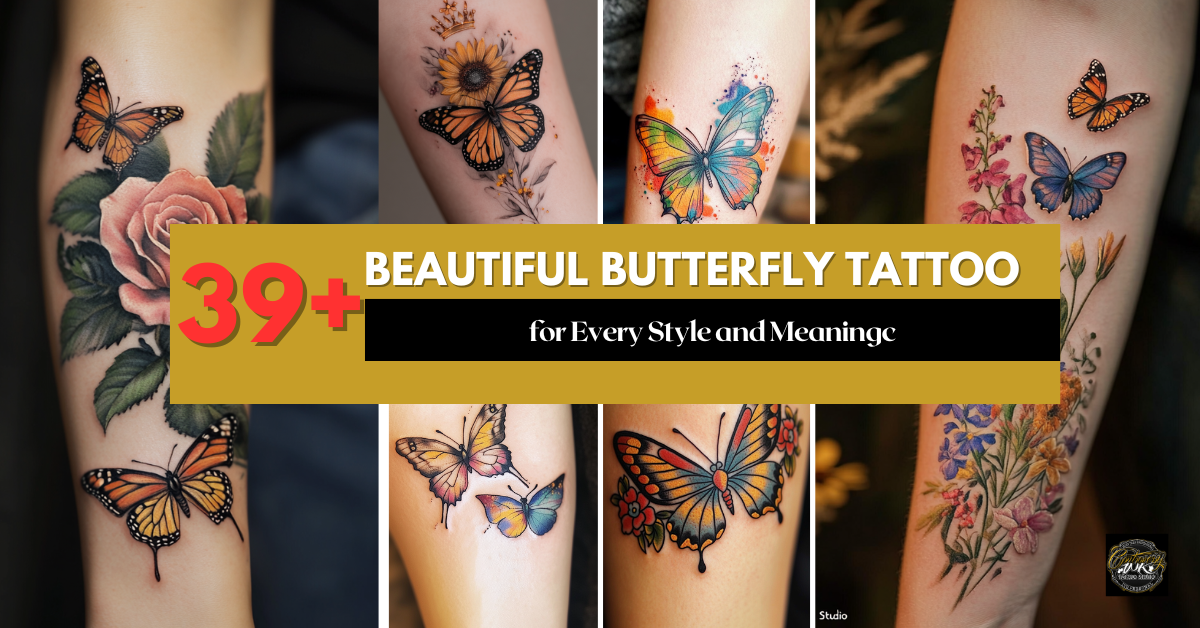If you buy through links on our site, we may earn a small affiliate commission to help support the blog - at no extra cost to you. It never influences our product selection process. Thank you!
Japanese tattoos, known as Irezumi, transcend ordinary body art to become living symbols of tradition, storytelling, and personal meaning. These timeless designs blend history with visual beauty, offering a harmony of artistry and cultural significance that’s unmatched in the tattoo world.
Whether you’re drawn to fierce dragons, serene koi fish, or powerful Daruma dolls, Japanese arm tattoos represent strength, resilience, and balance. Traditional Irezumi features bold lines and vibrant colors, created either through ancient hand-poking techniques or modern tattoo machines. From delicate cherry blossoms to mythical phoenixes, each motif carries profound symbolism that can be customized to reflect your personal journey.
The History and Traditions of Japanese Tattoo Art (Irezumi)
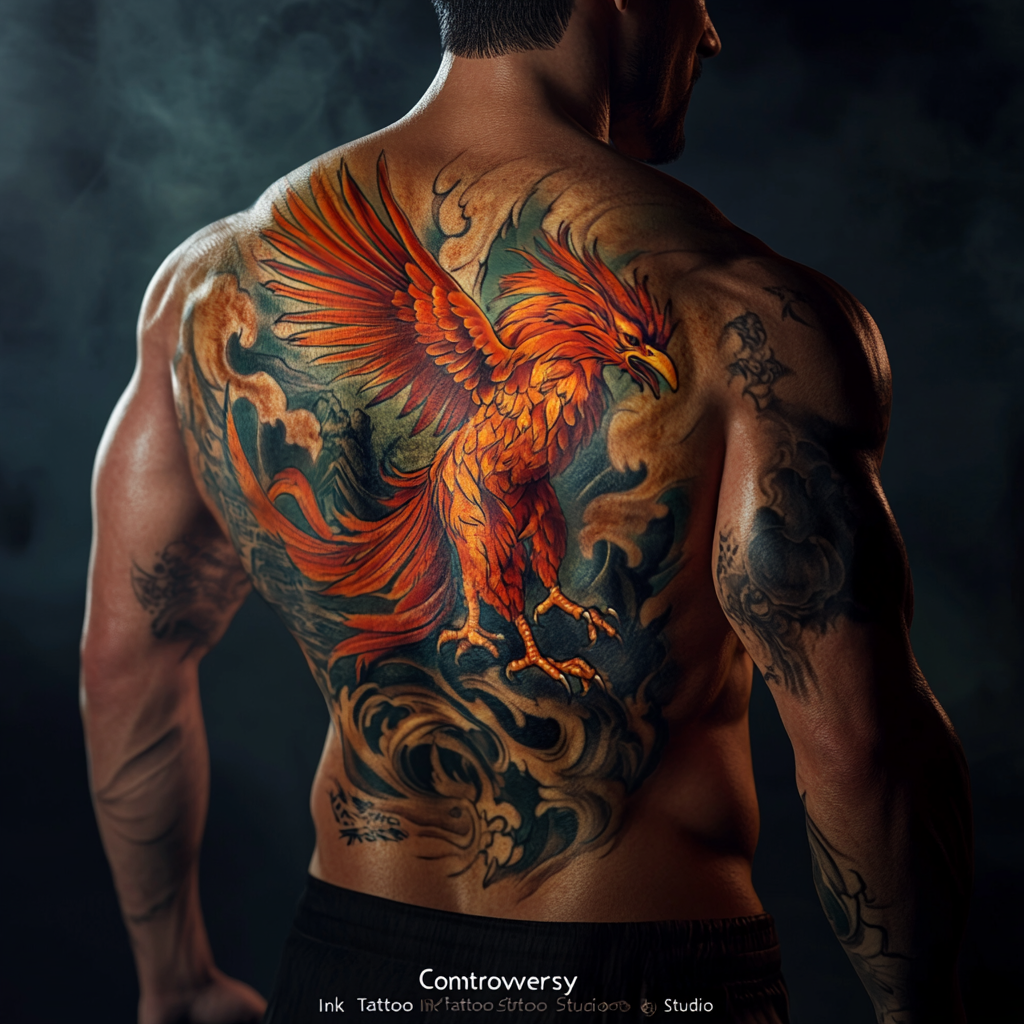
Ancient Beginnings
Japanese tattoos have roots dating back to the Jomon period (10500 BC to 300 BC), where clay figurines featuring markings resembling tattoos were first discovered. These early forms of body art laid the foundation for what would eventually become one of the world’s most respected tattoo traditions. Initially, tattoos in Japan served practical purposes, with decorative markings that may have indicated tribal affiliations or social status.
The Edo Period Evolution
The Edo period (1603-1868) marked a crucial turning point for Japanese style tattoos. During this time, the art form truly flourished, becoming deeply connected with ukiyo-e woodblock prints. Tattoo artists created elaborate, detailed designs featuring mythological stories, religious symbols, and legendary creatures. These intricate tattoos evolved from simple markings to comprehensive body art that told stories across the wearer’s skin.
Punishment to Artform Transformation
What started as a method to mark criminals transformed into a sophisticated art form embraced by different social classes. Samurai warriors adorned their bodies with protective symbols and talismans believed to boost their morale and bravery during battles. These tattoos japanese style designs weren’t just decorative—they carried deep spiritual meaning and were thought to offer physical and metaphysical protection.
The Meiji Period Challenges
During the Meiji period (1868-1912), Japanese tattoos faced significant challenges when the government attempted to prohibit tattooing to align with Western perceptions. Authorities considered tattoos “barbaric” and incompatible with Japan’s modernization efforts. Despite these restrictions, tattooing continued underground among those who valued its cultural significance, helping preserve traditional techniques during difficult times.
The Yakuza Connection
Japanese style tattoos eventually became associated with the yakuza, Japan’s organized crime groups. These elaborate tattoos symbolized loyalty, courage, and rebellion against conventional society. Full-body suits called “horimono” became status symbols within these communities. While this connection added stigma to tattooing in Japanese society, it also helped maintain traditional tattooing methods through continued patronage.
Traditional Techniques
Traditional Japanese tattoos are created using the “tebori” method—a hand-poking technique where the artist uses a metal or bamboo tool with needles attached to manually insert ink under the skin. This labor-intensive process requires years of apprenticeship to master but produces distinctive results with rich color saturation and exceptional detail that machine tattooing can’t replicate. Many purists still seek this authentic approach despite the pain and time investment involved.
Cultural Symbolism
Irezumi designs aren’t chosen merely for aesthetic appeal—each element carries specific meaning within Japanese culture. Dragons represent wisdom and strength, koi fish symbolize perseverance and determination, and cherry blossoms reflect the beautiful but fleeting nature of life. When you choose a Japanese style tattoo, you’re not just selecting a design but adopting a piece of cultural heritage with layers of symbolic significance.
Modern Revival
Today, Japanese tattoos have experienced global recognition and appreciation despite remaining somewhat taboo in Japan itself. Contemporary tattoo artists worldwide study traditional Japanese techniques and imagery while adding their own interpretations. This revival has brought renewed interest in the art form’s history and cultural significance, with many collectors specifically seeking Japanese style tattoos for their depth of meaning and artistic merit.
Understanding the Symbolism of Japanese Tattoo Elements
Traditional Meanings Behind Japanese Tattoos
Japanese tattoos, or Irezumi, are deeply rooted in symbolism with every design element carrying profound meaning. These tattoos aren’t merely decorative—they tell stories through carefully selected imagery:
- Koi Fish: Symbolizing perseverance and determination, koi fish tattoos represent the journey of overcoming obstacles. The legend of koi swimming upstream and transforming into dragons makes these designs particularly meaningful for those facing life challenges.
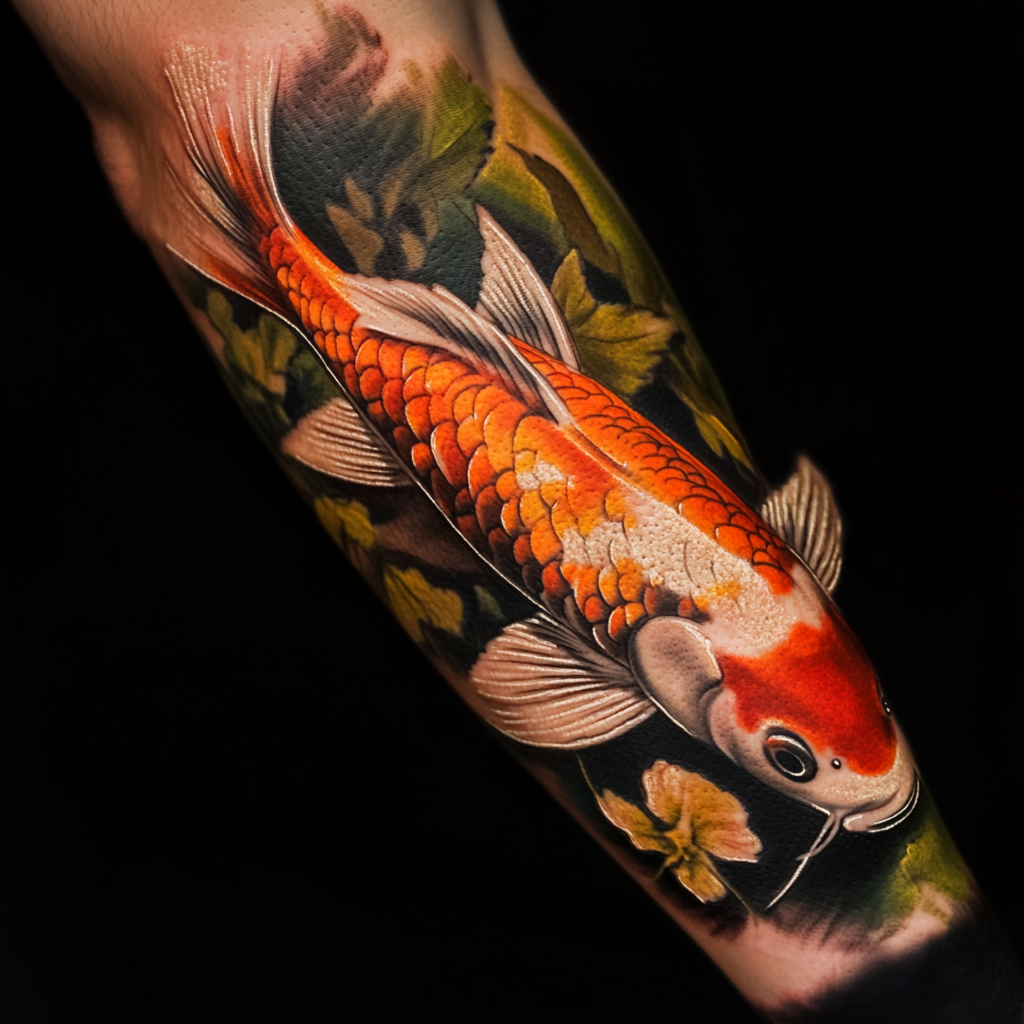
- Dragons: Unlike their Western counterparts, Japanese dragons are benevolent guardians embodying wisdom, power, and protection. Dragon tattoos serve as symbols of balance, freedom, and good fortune, making them a popular choice for those seeking strength and guidance.

- Cherry Blossoms: These delicate flowers represent the transient nature of life—”mono no aware”—the awareness of impermanence. A cherry blossom tattoo reminds us to appreciate life’s fleeting beauty and live in the present moment.

- Lotus Flowers: Emerging beautiful from muddy waters, lotus tattoos symbolize rising above struggles and spiritual awakening. They’re perfect for those who’ve overcome difficult circumstances.
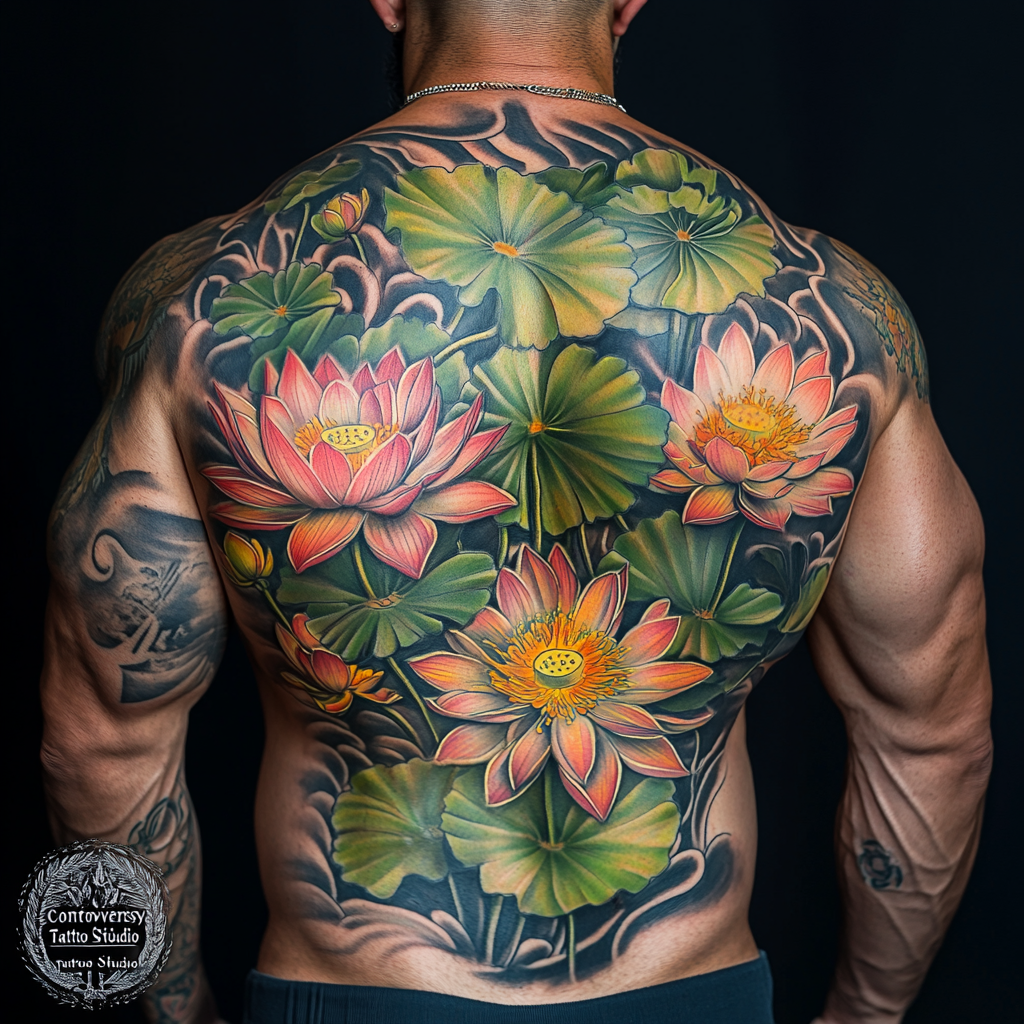
- Peonies: Known as the “king of flowers” in Japanese culture, peony tattoos represent prosperity, good fortune, and masculine energy despite their delicate appearance.

- Daruma Dolls: These distinctive figures represent perseverance and the ability to overcome obstacles. Their determined expressions make them powerful symbols of resilience.

Cultural Significance and Taboos
Japanese style tattoos carry complex cultural meanings that have evolved dramatically throughout history:
- Historical Protection: During early periods, tattoos functioned as spiritual protection, especially among laborers and fishermen who believed their ink would ward off sea monsters and bring good fortune.
- Edo Period Transformation: The art form flourished during the Edo period (1603-1868), becoming intrinsically linked with ukiyo-e woodblock prints. Artists developed elaborate narrative designs featuring religious symbols and mythical creatures.
- Criminal Associations: Initially used to mark criminals as punishment, this association has influenced perceptions of tattoos in Japanese society. This historical context explains some of the lingering stigma.
- Yakuza Connection: The adoption of full-body tattoos by yakuza (Japanese organized crime groups) as symbols of loyalty, courage, and rebellion reinforced negative connotations while simultaneously preserving traditional tattooing practices during periods of prohibition.
- Modern Taboos: Despite global appreciation for Japanese tattoo artistry, many public baths, hot springs, gyms, and swimming pools in Japan still prohibit visible tattoos—regardless of their design or the wearer’s background.
- Cultural Appreciation vs. Appropriation: When choosing Japanese style tattoos, it’s important to understand and respect their cultural significance rather than selecting designs purely for aesthetic value.
The symbolism in Japanese tattoos transforms them from mere body art into meaningful narratives of personal values, aspirations, and spiritual beliefs. Each element is chosen not just for its visual appeal but for the layers of significance it brings to the wearer’s life story.
Japanese Mythological Creatures for Powerful Tattoo Designs
Dragons and Their Representation

Japanese dragons (ryu) are among the most sought-after motifs in traditional Japanese style tattoos. Unlike their Western counterparts, Japanese dragons symbolize wisdom, protection, and good fortune rather than malevolence. These majestic creatures are typically depicted with serpentine bodies, four legs with sharp claws, and distinctive horned heads.
In Japanese tattoo art, dragons often appear swimming through clouds or waves, creating dynamic movement across the skin. The colors used in dragon tattoos carry specific meanings—black dragons represent wisdom and experience, while blue dragons symbolize gentleness and forgiveness. Gold or yellow dragons signify value and prosperity.
When incorporated into sleeve designs or back pieces, dragon tattoos create powerful visual impact. Their flowing forms make them perfect for wrapping around limbs or stretching across broader areas of skin. Many tattoo enthusiasts choose dragon designs that incorporate other elements like cherry blossoms or waves to enhance the storytelling aspect of their Japanese style tattoos.
Koi Fish and the Story of Perseverance

Koi fish tattoos represent one of the most meaningful designs in Japanese tattoo tradition. Based on the legend of the koi fish swimming upstream against the Yellow River’s current and transforming into a dragon, these tattoos symbolize perseverance, determination, and overcoming life’s obstacles.
The direction of the koi in your tattoo matters significantly. A koi swimming upstream indicates you’re still working toward your goals, while a downward-swimming koi suggests you’ve already overcome major challenges. The colors used in koi tattoos also carry distinct meanings—red represents love and strength, black signifies overcoming obstacles, and blue symbolizes masculinity and reproduction.
Many Japanese style tattoos feature koi fish swimming through turbulent waters, often paired with lotus flowers or cherry blossoms to create contrast. These designs work beautifully as arm sleeves, thigh pieces, or back tattoos, with the fish’s flowing movement guiding the eye through the composition. The intricate scales and vibrant colors make koi fish tattoos both visually striking and rich with personal significance.
Phoenix as a Symbol of Rebirth
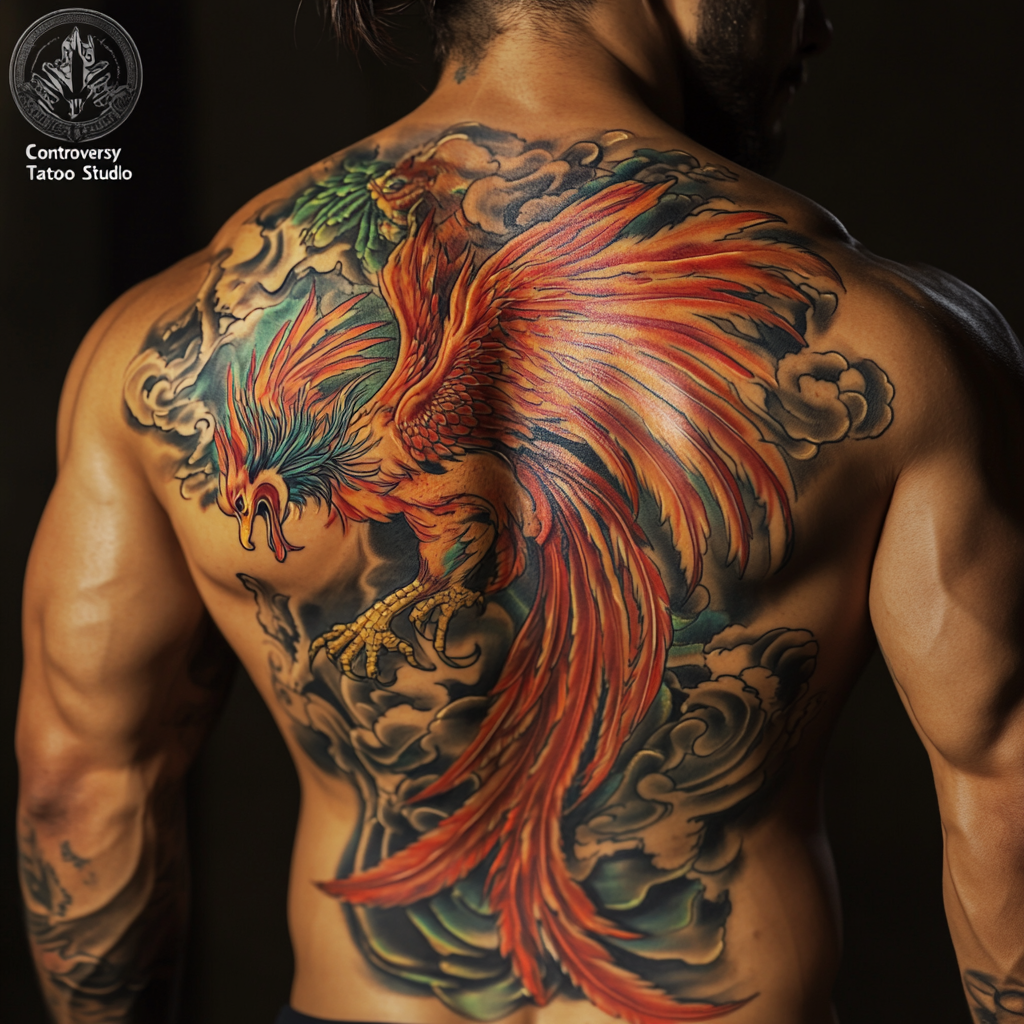
The phoenix (ho-o) in Japanese tattoo tradition represents rebirth, triumph, and renewal. This mythical bird, believed to live for 500 years before bursting into flames and rising from its own ashes, makes for a powerful and meaningful tattoo design. In Japanese mythology, the phoenix appears only during times of peace and prosperity, making it a symbol of good fortune.
Japanese style phoenix tattoos typically feature dramatic flames, elaborate tail feathers, and vibrant colors—primarily reds, oranges, and golds. The bird is often portrayed with its wings spread wide, creating a design that works beautifully across the chest, back, or as a sleeve. The dynamic nature of the phoenix allows artists to create movement and flow that follows the body’s natural contours.
Many tattoo enthusiasts choose the phoenix to mark significant life transitions or personal transformations. The design pairs well with other Japanese motifs such as peonies (representing prosperity) or cherry blossoms (symbolizing the impermanence of life). For a truly striking tattoo, consider a phoenix and dragon combination, representing the balance between yin and yang energies.
Animal-Inspired Japanese Tattoo Ideas
Animals play a significant role in Japanese tattoo art, each carrying powerful symbolism and cultural significance. These designs blend artistic beauty with deep meaning, making them popular choices for those seeking Japanese style tattoos with substance.
Tiger and Lion Designs
Tigers hold a special place in Japanese tattoo tradition despite not being native to Japan. Introduced through Chinese and Korean influences, tiger tattoos in Japanese style (irezumi) represent courage, strength, and protection against evil spirits. Often depicted with dramatic expressions and dynamic poses, these majestic creatures symbolize the wind element in Japanese culture.
When choosing a Japanese style tiger tattoo, you’ll find various artistic interpretations:
- Traditional tigers with bold black outlines and vibrant orange coloring
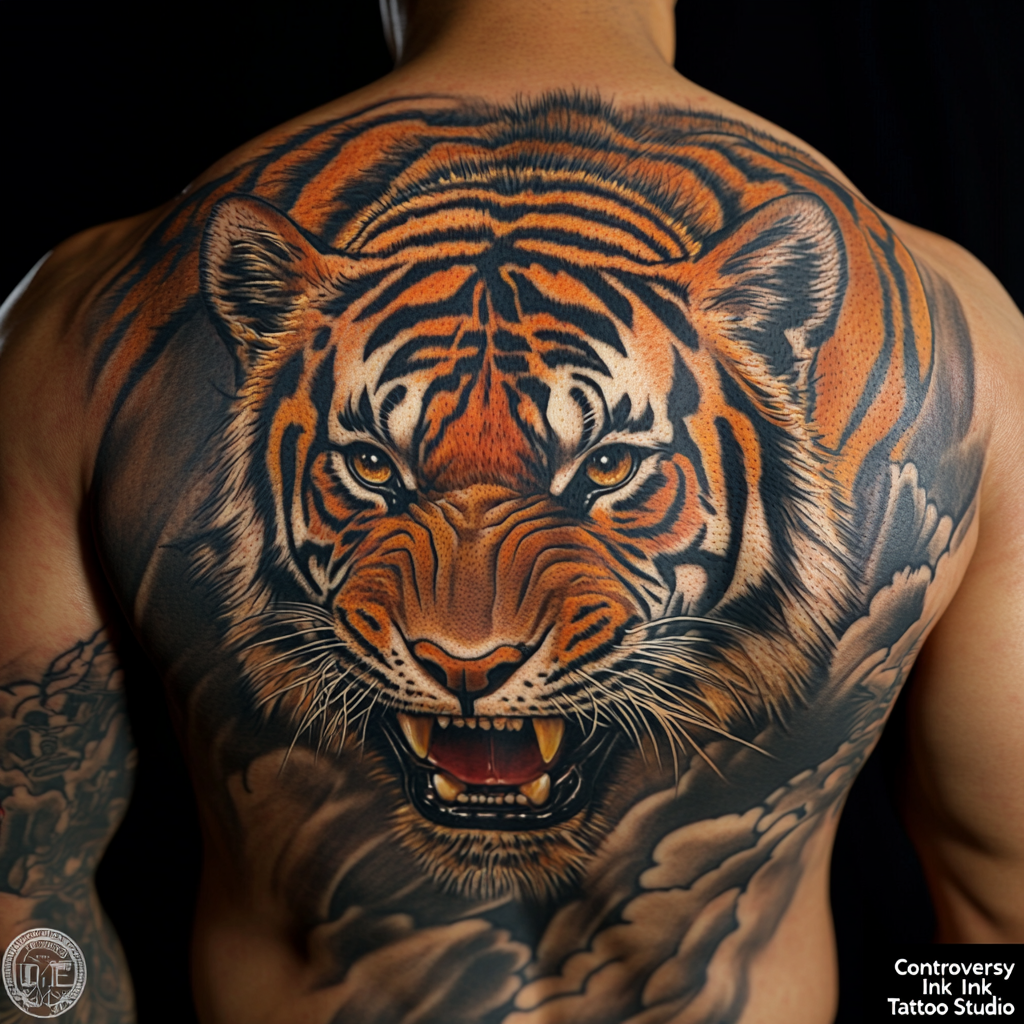
- Wind-bar tigers surrounded by swirling gusts, emphasizing their connection to natural forces

- Tigers paired with bamboo, representing strength and resilience together

- Winter tigers amid snow, symbolizing perseverance through difficult times
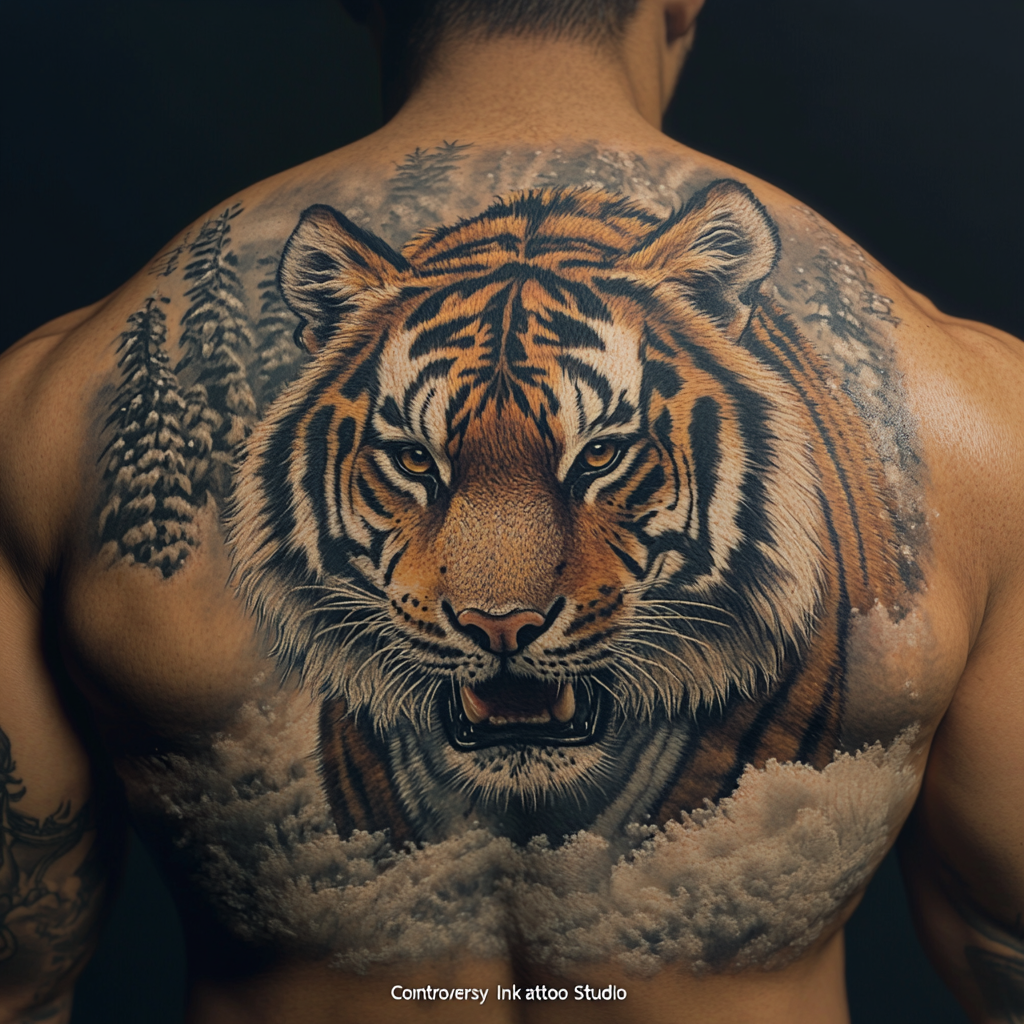
Lion tattoos (often depicted as shishi or foo dogs) serve as guardian figures in Japanese tattoo art. These mythical lion-dog hybrids traditionally guard temple entrances and now protect the wearer’s body when rendered in tattoo form. Their fierce expressions and powerful stances make for striking tattoo designs that convey protection and courage.
Snake and Frog Symbolism
Snake tattoos hold complex meanings in Japanese tattoo tradition. The snake (hebi) represents wisdom, protection, good luck, and regeneration due to its shedding skin. In Japanese style tattoos, snakes are typically portrayed with intricate scales, sometimes coiled around weapons, skulls, or flowers to create contrasting visual elements.
Popular Japanese snake tattoo variations include:
- White snakes, considered divine messengers associated with the deity Benzaiten
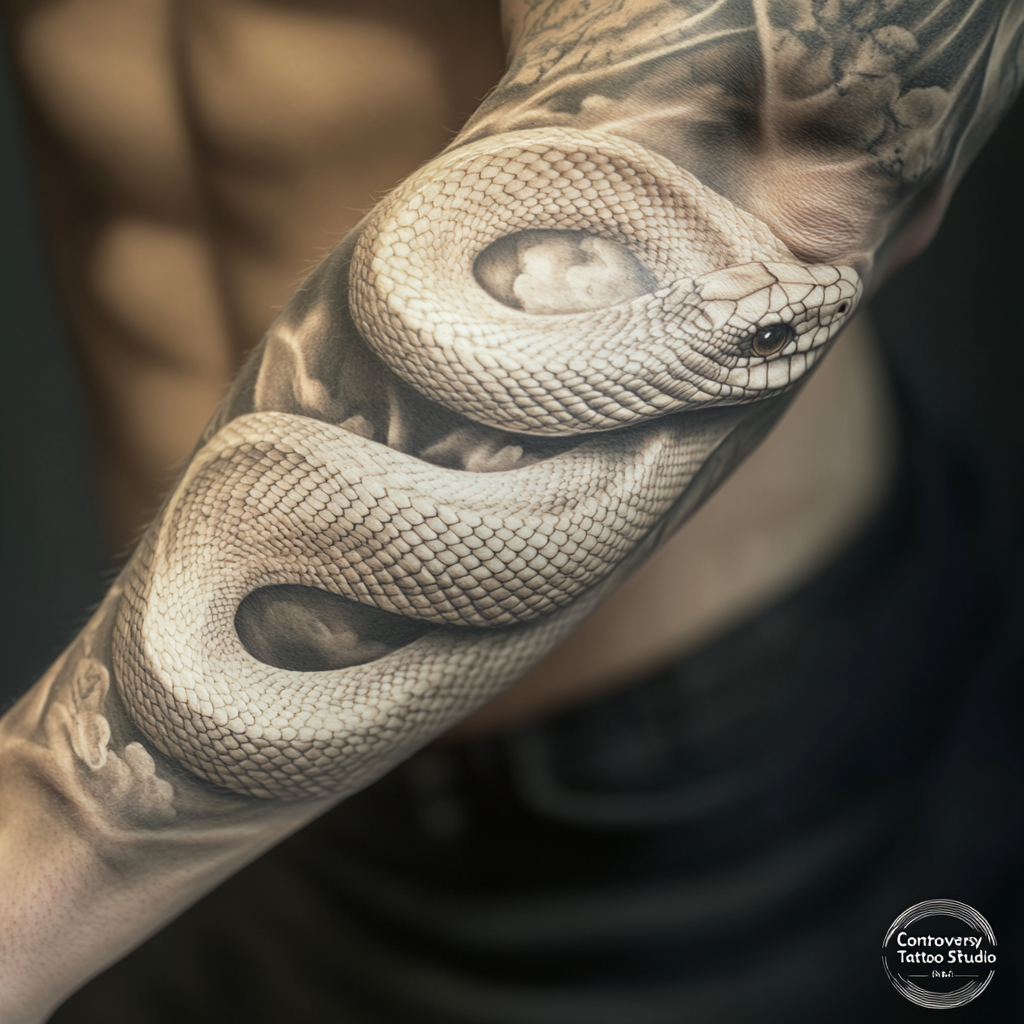
- Black snakes paired with chrysanthemums, representing balance between danger and beauty

- Snakes with peonies, symbolizing protection of prosperity and wealth
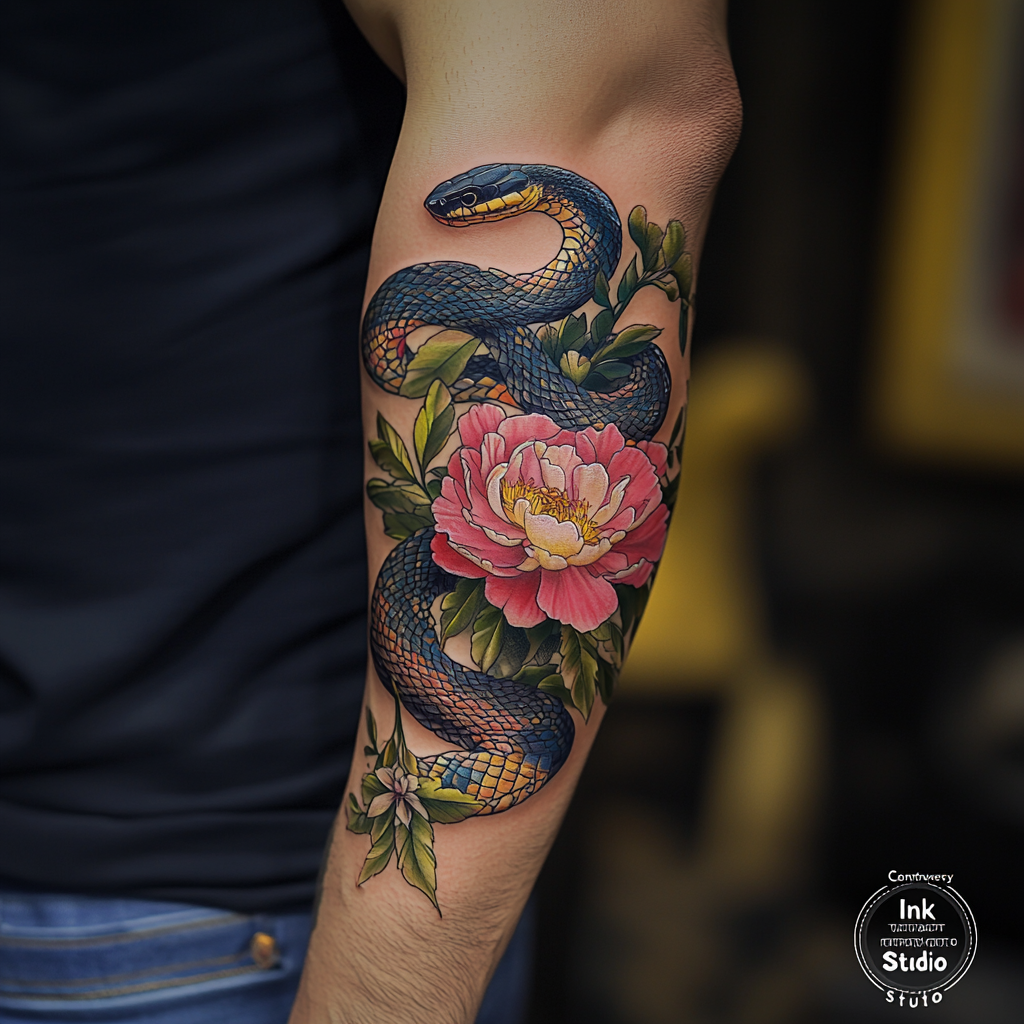
- Coiled snakes ready to strike, conveying readiness and alertness

Frog tattoos might seem unusual, but they carry significant meaning in Japanese tattoo art. The Japanese word for frog (kaeru) sounds identical to the word meaning “to return,” making frogs symbols of safe journeys and good fortune. Travelers and merchants historically favored frog tattoos as protective talismans.
When depicted in Japanese style tattoos, frogs often appear:
- Sitting on lily pads, representing patience and tranquility
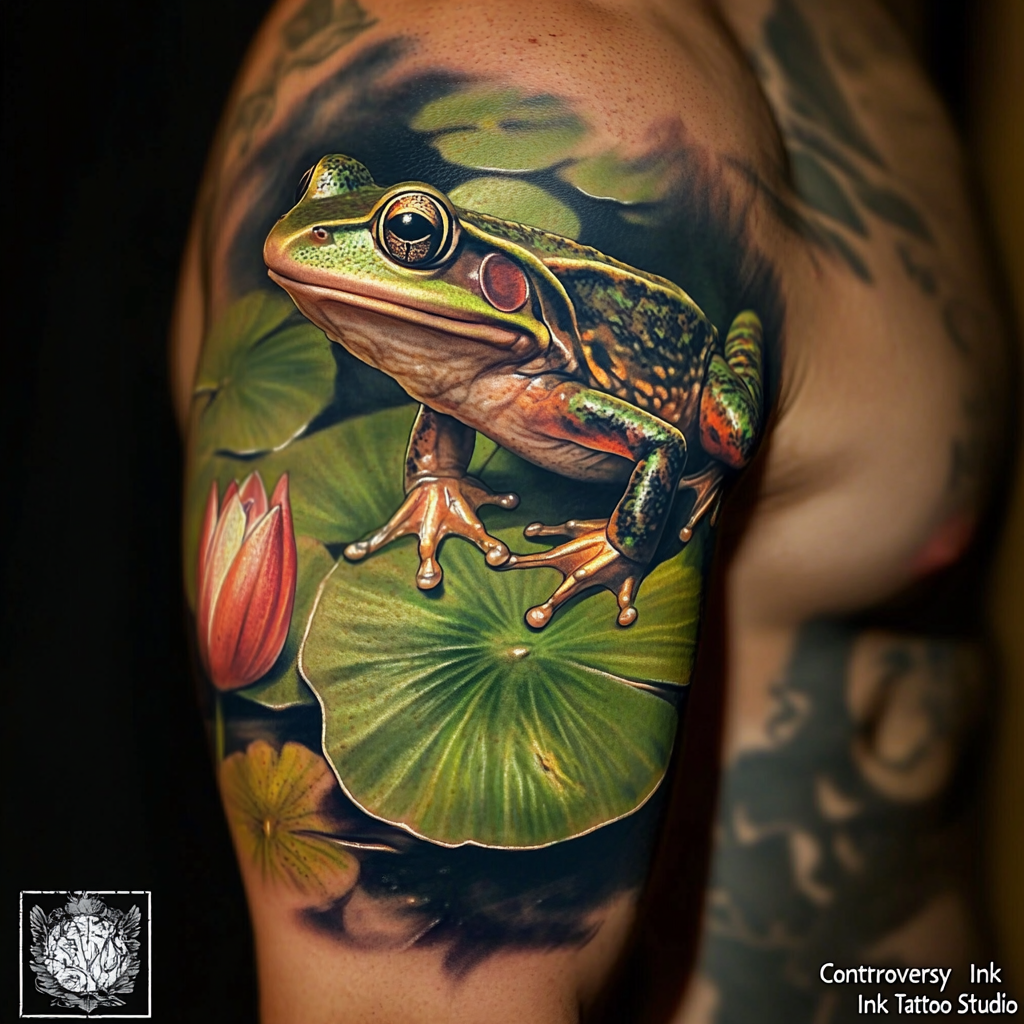
- In groups, symbolizing abundance and prosperity

- As the famous three-legged frog (Gama), associated with wealth attraction

- With coins, reinforcing their connection to financial good fortune
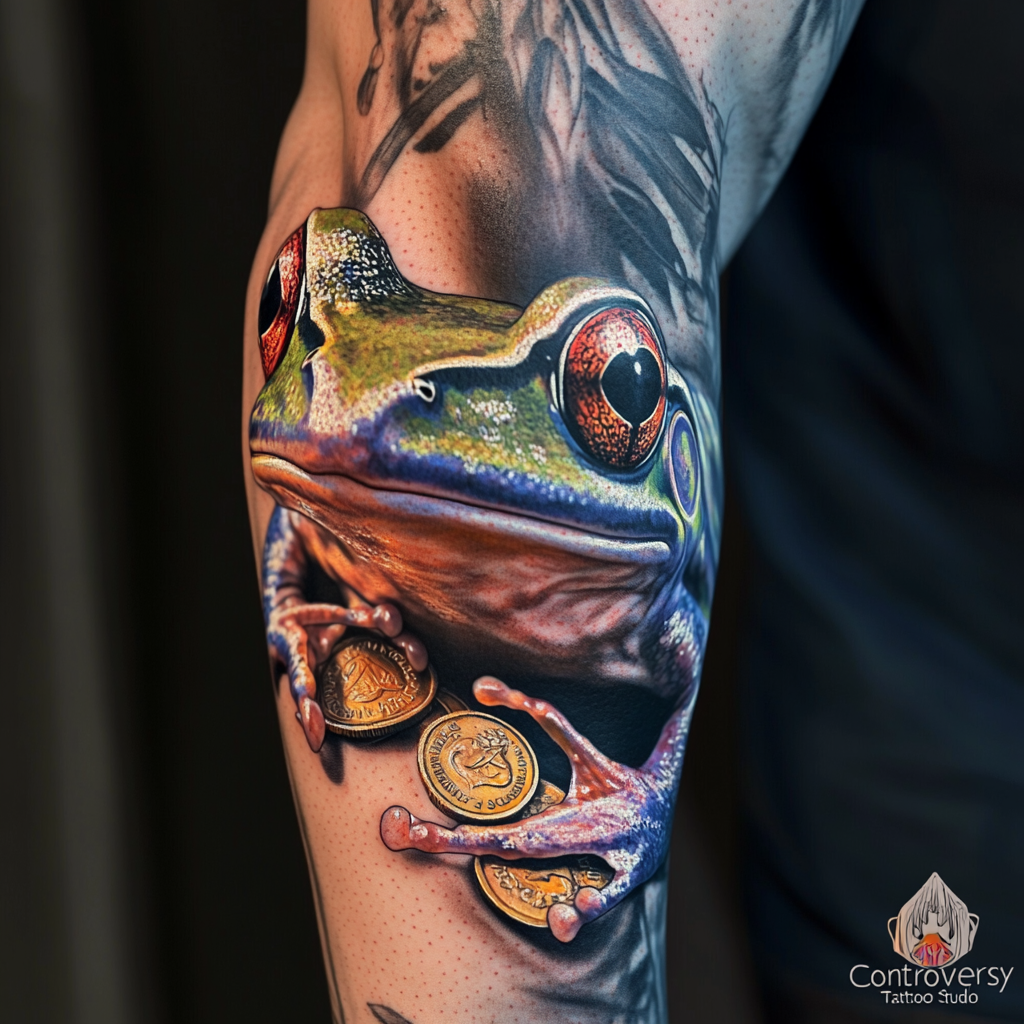
Octopus (Tako) Imagery

The octopus holds a distinctive place in Japanese style tattoos, representing flexibility, intelligence, and adaptability. Traditional Japanese tattoo artists masterfully depict these creatures with flowing tentacles that work perfectly with the body’s contours, making them ideal for areas like shoulders, chest, or back.
In Japanese folklore, octopuses are associated with:
- Cunning intelligence and problem-solving abilities
- Sexual energy and fertility (in some historical contexts)
- The ability to escape difficult situations by changing form
- Persistence and determination
Japanese style octopus tattoos typically feature:
- Dynamic tentacles that create movement across the skin’s surface
- Realistic suction cups rendered in meticulous detail
- Traditional ukiyo-e inspired coloring with blues, reds, and purples
- Combinations with other marine elements like waves, shells, or pearl divers
The tako (octopus) tattoo beautifully represents the Japanese aesthetic principle of depicting nature’s creatures with both artistic license and respect for their essential characteristics. Whether rendered in full color or black and gray, these designs capture the fluid movement and mysterious nature of one of the ocean’s most intelligent creatures.
Human Figures in Japanese Tattoo Art
Human figures hold a special place in Japanese tattoo art, embodying stories of courage, beauty, and emotion through their distinctive portrayals. These character-based designs offer powerful imagery that connects deeply with Japanese cultural heritage.
Samurai Warriors: Honor and Discipline

Samurai tattoos in Japanese style represent the ultimate symbols of honor, courage, and loyalty. These warrior designs feature intricate details of armor, helmets, and weapons that showcase the meticulous nature of traditional Japanese tattooing. When you choose a samurai tattoo, you’re embracing the bushido code—a set of principles centered around respect, integrity, and discipline.
Bushi warrior tattoos, commonly depicting masked samurai, make particularly powerful statements on sleeves or back pieces. These designs often incorporate elements like cherry blossoms or waves to enhance their visual impact and symbolism. The contrast between the warrior’s strength and surrounding natural elements creates a balanced composition typical of Japanese tattoo aesthetics.
For a more personalized approach, consider featuring a samurai in dynamic poses—whether in battle, meditation, or with drawn katana. Each position conveys different aspects of the samurai spirit, from fierce determination to stoic contemplation. These tattoos work exceptionally well as large-scale pieces where the artist can capture fine details of facial expressions and armor textures.
Geishas: Beauty and Grace
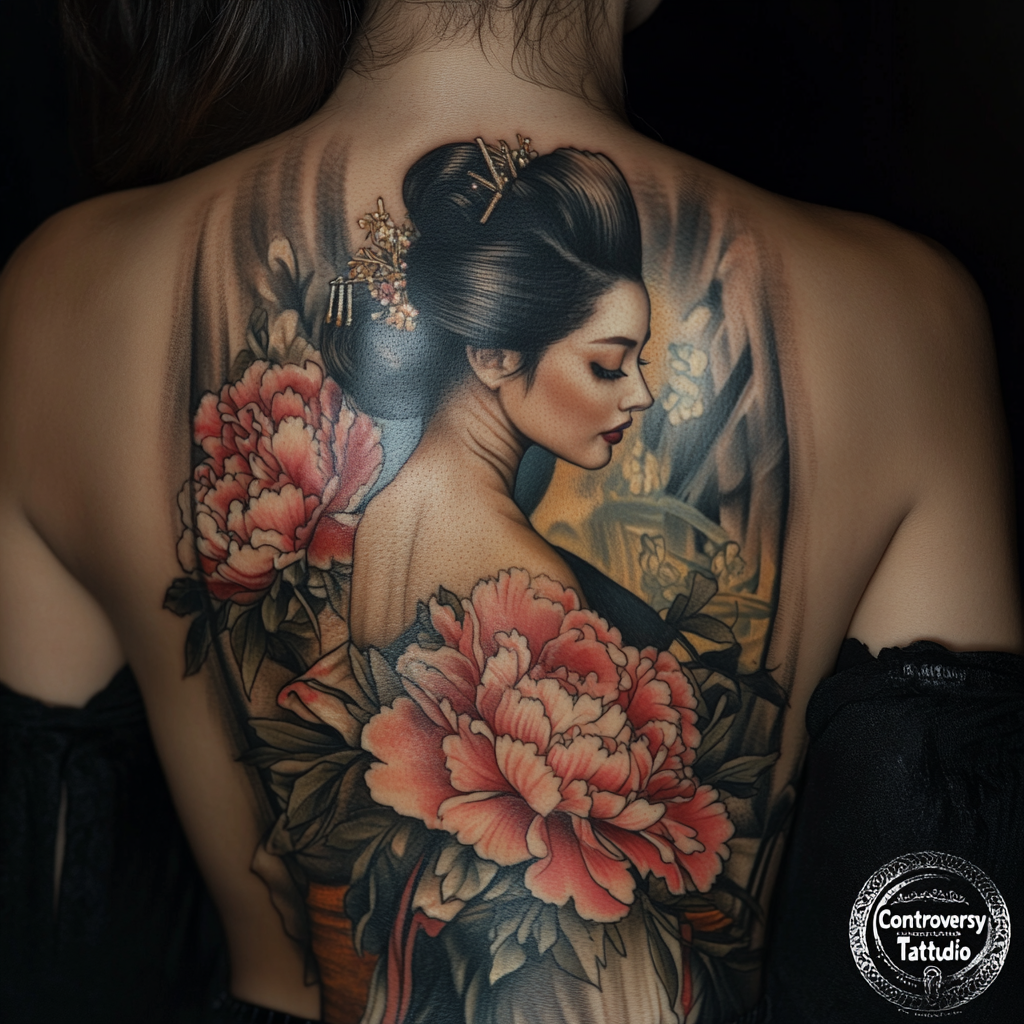
Geisha tattoos embody feminine beauty, artistic refinement, and cultural sophistication in Japanese style tattoos. These elegant figures represent more than just physical beauty—they symbolize dedication to artistic perfection and the complexity of Japanese feminine ideals. Traditional geisha tattoos feature women in elaborate kimonos with distinct white-painted faces and ornate hairstyles adorned with decorative kanzashi hairpins.
The symbolism in geisha tattoos extends beyond their visual appeal. They represent strength, resilience, and artistic mastery—qualities that made geishas respected cultural icons. When incorporated into larger pieces, geisha designs often include elements like cherry blossoms, peonies, or maple leaves to enhance their seasonal and symbolic connections.
Modern interpretations of geisha tattoos range from highly traditional to stylized neo-Japanese versions. Some artists create more mysterious compositions with geishas partially hidden behind fans or umbrellas, adding layers of meaning about revelation and concealment. These tattoos work particularly well on arms, thighs, or back pieces where their elegant poses can follow the body’s natural contours.
Hannya and Oni Masks: Emotion and Demons

Hannya and oni masks represent some of the most powerful emotional imagery in Japanese style tattoos. The Hannya mask, depicting a jealous female demon, showcases transformation through its horns, metallic eyes, and sharp fangs—all while maintaining traces of human features. This duality makes it a profound symbol of complex emotions like rage, jealousy, and sorrow emerging from love and attachment.
Hannya mask tattoos often incorporate contrasting elements to enhance their meaning. The split-design Hannya tattoo—showing half demon, half human—illustrates the mask’s representation of emotional duality. These designs frequently include elements like chrysanthemums, peonies, or snake motifs to add layers of symbolism about transformation and emotional complexity.
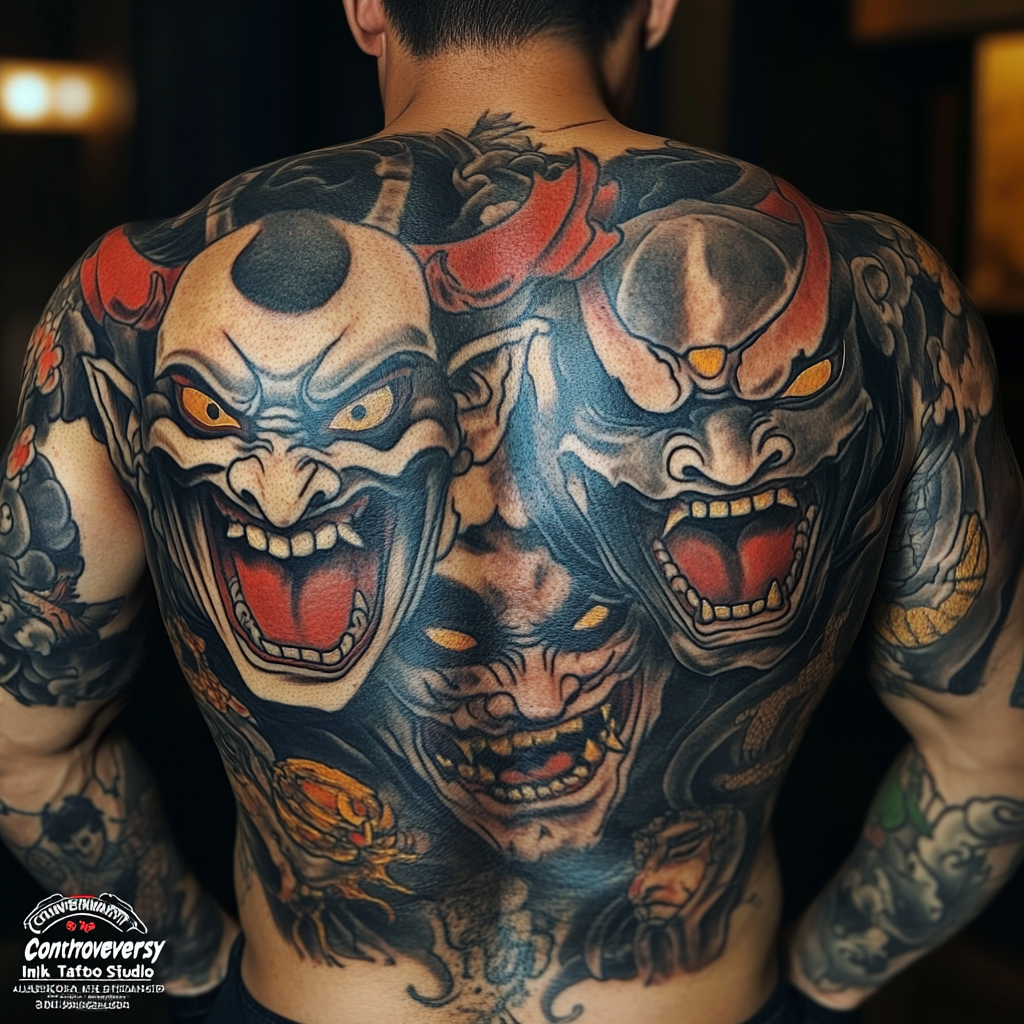
Oni masks, while similar in appearance to Hannya masks, specifically represent male demons in Japanese folklore. As tattoo subjects, oni designs symbolize protection against evil while acknowledging darker human emotions. Their vibrant colors—typically bold reds, blues, or blacks—make them visually striking choices for Japanese style sleeve tattoos or chest pieces. When choosing between these mask designs, consider the emotional journey you want your tattoo to represent, as each carries distinct cultural connotations while sharing the powerful visual language of Japanese tattoo traditions.
Natural Elements in Japanese Tattoo Composition
Floral Designs (Cherry Blossoms, Lotus, Chrysanthemum)
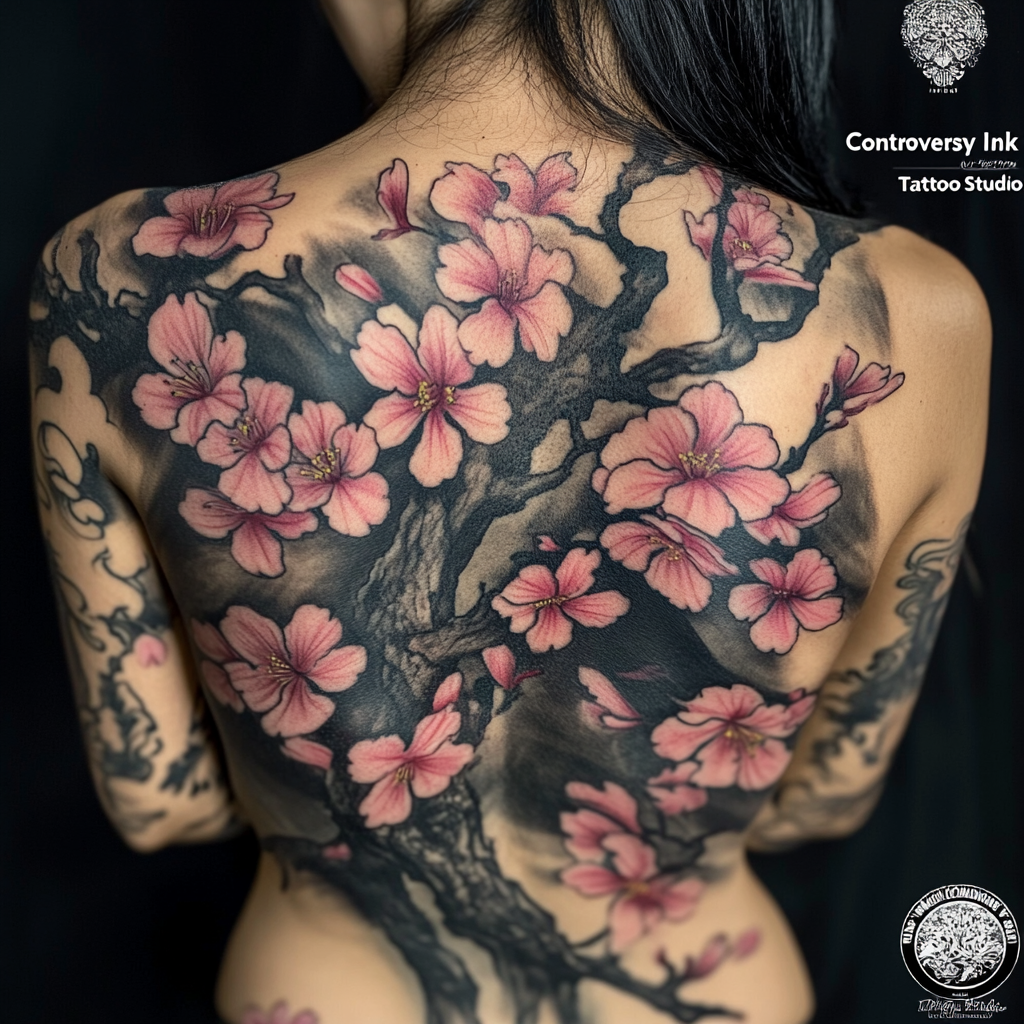
Cherry blossoms (sakura) embody the essence of Japanese tattoo style with their profound symbolism of life’s beauty and impermanence. These delicate pink blooms serve as reminders that life is breathtakingly beautiful yet fleeting, making them particularly popular in Japanese tattoo compositions. When incorporated into your tattoo design, cherry blossoms can create stunning cascades of petals that flow naturally with the body’s contours.

Lotus flowers represent spiritual awakening and purity in Japanese tattoos. Despite growing from muddy waters, the lotus emerges clean and beautiful, symbolizing triumph over adversity. Your lotus tattoo can feature various stages of bloom, each conveying different meanings—from closed buds representing potential to fully open flowers symbolizing enlightenment.
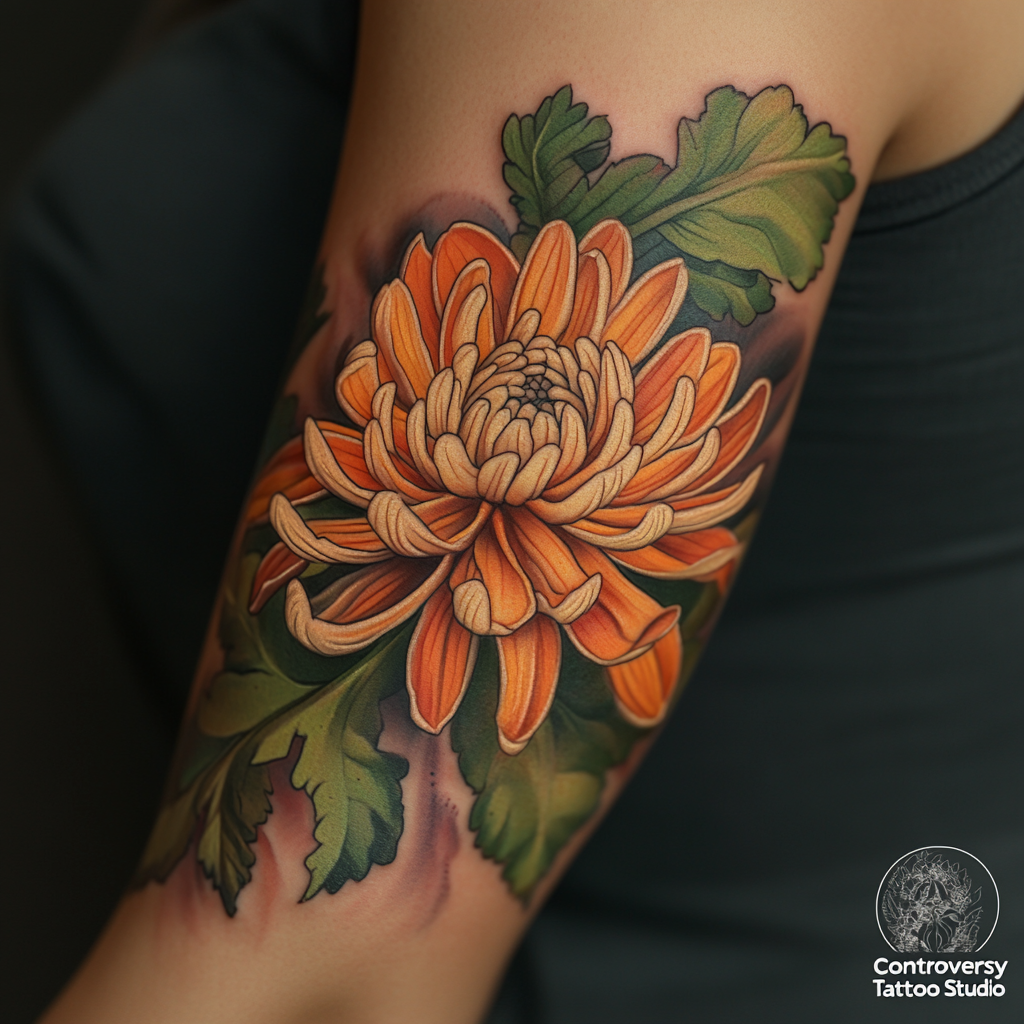
Chrysanthemums hold special significance in Japanese culture as symbols of the imperial family and longevity. In tattoo form, these intricate flowers with their many-layered petals create visually striking focal points. Often rendered in vibrant colors, chrysanthemum tattoos represent perfection, nobility, and joy in Japanese style tattoos, making them ideal for larger areas like back pieces or chest tattoos.
Waves, Wind, and Water Representations

Water elements form fundamental components in traditional Japanese tattoo composition, with waves being among the most iconic. Dynamic wave patterns inspired by ukiyo-e woodblock prints like Hokusai’s “Great Wave” create motion and energy in your tattoo design. These waves often serve as background elements that connect other motifs while representing life’s constant changes and the power of nature.

Wind bars are distinctive swirling patterns that visualize air movement in Japanese tattoos. They’re essential for creating flow and dynamism in your design, often connecting various elements while guiding the eye throughout the composition. Wind bars work exceptionally well as background elements in sleeve tattoos, helping main subjects like dragons or koi fish appear to move naturally with the body.

Water splashes provide dramatic impact in Japanese style tattoos, creating contrast and emphasizing the dynamic nature of primary design elements. When incorporated around koi fish or dragons, water splashes suggest these creatures are actively moving through their environment. These elements require skilled application to render properly, with varying thicknesses in lines creating depth and dimension in your tattoo.
Bamboo and Mountain Imagery

Bamboo symbolizes strength with flexibility in Japanese tattoo art, representing resilience and the ability to bend without breaking. Your bamboo tattoo design can range from simple, elegant stalks to more elaborate compositions featuring bamboo groves. The straight sections and distinctive nodes create natural lines that complement the body’s form, making bamboo particularly effective in arm and leg tattoos.

Mountain imagery in Japanese tattoos often represents stability, permanence, and spiritual ascension. Mount Fuji, Japan’s sacred volcano, appears frequently in traditional designs, instantly recognizable with its distinctive snow-capped peak. When incorporated into larger Japanese style tattoos, mountains typically create backdrop elements that ground other symbols while adding depth to the overall composition.
Pine trees appear regularly in Japanese tattoo compositions as symbols of longevity, wisdom, and endurance. These evergreens remain strong through winter’s harshness, representing resilience and steadfastness. In tattoo design, pine trees often appear windswept on mountainsides or as standalone elements, with their distinctive silhouettes creating striking visual interest while enhancing the natural theme of your Japanese style tattoo.
Modern Interpretations of Japanese Tattoo Style
Neo-Japanese Tattoo Innovations

Neo-Japanese tattoos breathe fresh life into traditional irezumi while honoring its cultural roots. This contemporary style emerged in the late 20th century and gained significant popularity in the United States and Europe during the 2000s, largely due to increased exposure to Japanese culture through the internet and media.
Unlike traditional Japanese tattoos with their strict rules and conventions, neo-Japanese designs take creative liberties while maintaining core elements. Artists incorporate traditional imagery like dragons and koi fish but enhance them with:
- Expanded color palettes beyond the traditional Japanese spectrum
- Integration of pop culture references and abstract design elements
- More intricate detailing and dimensional shading techniques
- Personal symbolism that resonates with modern tattoo enthusiasts
Neo-Japanese tattoos often feature the same beloved motifs as traditional pieces but with creative twists that make them distinctly contemporary. The style appeals to those who appreciate Japanese tattoo aesthetics but want something that reflects modern sensibilities and individual expression.
Fusion With Contemporary Tattoo Techniques

Modern Japanese style tattoos blend time-honored symbolism with cutting-edge tattooing methods. Today’s artists are fusing traditional elements with contemporary techniques to create designs that honor the past while embracing modern innovations:
- State-of-the-art equipment delivers vibrant colors that make traditional designs pop
- Advanced shading techniques create almost three-dimensional effects
- Watercolor-inspired backgrounds add ethereal qualities to traditional motifs
- Geometric patterns integrate with traditional Japanese imagery
- Digital design processes allow for precise planning of complex pieces
The fusion approach transforms traditional Japanese tattoos into fresh, dynamic works of art. Artists might incorporate photorealistic elements alongside stylized Japanese figures or blend traditional line work with contemporary color theory. These hybrid designs often feel more accessible to those new to Japanese tattoo imagery while maintaining a connection to the style’s rich history.
Modern tattoo artists specializing in Japanese style continue forming deep relationships with clients, as these detailed pieces—especially larger works like sleeves and back pieces—still require multiple sessions and significant commitment. However, contemporary techniques have expanded possibilities for smaller, standalone Japanese-inspired tattoos that capture the essence of the style without the traditional full-body commitment.
Choosing the Perfect Placement for Your Japanese Tattoo
Traditional Placement Considerations
Traditional Japanese tattoos often cover large areas of the body, creating a cohesive and flowing artwork. The placement of your Japanese style tattoo significantly impacts both its visual appeal and symbolic meaning. Back pieces (known as “sokushin-bori”) offer the largest canvas for elaborate scenes featuring dragons, koi, or samurai warriors. Arm sleeves (“nagasode”) provide excellent visibility and allow for dynamic designs that wrap around your limb, creating movement when you flex or extend your arm. Chest panels (“hikae”) serve as powerful statement pieces and are traditionally reserved for motifs representing protection or personal values.
Size and Flow of Japanese Designs
Japanese style tattoos are renowned for their flow and composition that harmonizes with the body’s natural contours. Large-scale pieces follow the body’s muscle structure and movement patterns. Full sleeves typically start at the shoulder and extend to the wrist, incorporating multiple elements that tell a complete story. Half-sleeves ending at the elbow allow for concealment while still providing ample space for detailed work. Thigh and leg placements provide extensive canvases for vertical designs like dragons or koi swimming upstream. Consider how your tattoo will move with your body—designs that follow muscles appear more dynamic and integrated with your physique.
Best Body Parts for Specific Motifs
Different Japanese tattoo motifs work better on specific body parts. Dragons flow beautifully across the back, chest, or down arms, allowing their sinuous bodies to curve naturally with your anatomy. Koi fish swimming upstream create striking visuals when placed vertically on thighs or arms, symbolizing perseverance through life’s challenges. Cherry blossoms and other floral elements work well as background or filler patterns and can adorn shoulders, chest, or be scattered throughout larger pieces. Hannya masks and portrait-based designs are often positioned on flat areas like the outer arm, thigh, or back to preserve their dramatic facial expressions and intricate details.
Visibility and Social Considerations
When choosing placement for your Japanese style tattoo, consider your lifestyle and social environment. Forearm pieces offer high visibility but may not suit all workplace environments. Upper arms and shoulders provide the flexibility to display or conceal your artwork depending on the situation. Back pieces offer extensive canvas space while remaining private unless deliberately revealed. Ribcage and side placements deliver dramatic visual impact while staying hidden under everyday clothing. In Japanese culture, tattoos still carry certain stigmas—visible tattoos may restrict access to public baths, gyms, and certain establishments, so placement decisions warrant careful consideration if you plan to visit Japan.
Pain Factors and Healing Considerations
Different body locations experience varying levels of discomfort during tattooing. Areas with thin skin over bone—like ribs, spine, feet, hands, and collarbones—typically cause more discomfort than fleshier regions like upper arms, thighs, and calves. Traditional Japanese tattoos often require multiple lengthy sessions, so choosing a placement you can tolerate for extended periods is crucial. Additionally, certain areas heal more easily than others. Locations that experience frequent friction or movement (like joints, hands, and feet) may require special aftercare and could take longer to heal properly. Discuss these factors with your tattoo artist to develop a placement strategy that balances your pain tolerance with your artistic vision.
Finding the Right Artist for Your Japanese Style Tattoo
Japanese tattoos transcend mere body art to become profound personal narratives etched in skin. Whether you’re drawn to the strength of dragons the perseverance of koi fish or the beauty of cherry blossoms each design carries centuries of cultural significance.
As you embark on your Irezumi journey remember that research is essential. Find an artist who specializes in Japanese tattooing and respects its traditions while bringing their own expertise to your design.
Your tattoo will become a permanent expression of your values stories and aesthetic preferences. By choosing motifs that resonate with your personal journey you’ll wear not just beautiful artwork but meaningful symbols that honor both Japanese culture and your unique path through life.
Frequently Asked Questions
What is Irezumi and what does it represent?
Irezumi is the traditional Japanese tattooing style with centuries of history. It represents not just decorative body art but carries deep cultural significance, telling stories through symbolism. These tattoos often embody personal values, spiritual beliefs, and cultural narratives that reflect strength, protection, and transformation. Each design element is chosen for its specific meaning and contribution to the overall narrative.
What are common motifs in Japanese tattoos?
Common Japanese tattoo motifs include dragons (wisdom and power), koi fish (perseverance), cherry blossoms (beauty and impermanence of life), lotus flowers (spiritual awakening), tigers (courage), samurai (honor), geisha (feminine strength), and mythological creatures like phoenixes (rebirth). Natural elements such as waves and wind are also frequently incorporated to create motion and energy in designs.
How has the cultural perception of Japanese tattoos evolved?
Japanese tattoos evolved from practical markings in the Jomon period to criminal markers, then to elaborate art forms during the Edo period. During the Meiji era, they were suppressed as “barbaric.” Despite their association with yakuza and resulting stigma, they’ve gained global recognition as a respected art form. In modern Japan, visible tattoos remain taboo in many public spaces, despite international appreciation.
What is the difference between traditional and neo-Japanese tattoo styles?
Traditional Japanese (Irezumi) tattoos follow strict aesthetic rules, use specific motifs, and are often created using the tebori hand-poking technique. Neo-Japanese tattoos, emerging in the late 20th century, maintain traditional imagery but incorporate expanded color palettes, pop culture references, and modern techniques. While respecting cultural roots, neo-Japanese offers more flexibility and contemporary appeal while preserving the narrative quality.
What is the tebori technique?
Tebori is the traditional hand-poking method of Japanese tattooing, where artists use hand-held tools rather than machines to insert ink into the skin. This labor-intensive technique involves bamboo or metal tools with needle groupings attached to the end. Though more time-consuming than machine tattooing, tebori creates distinctive results with a unique texture and depth that many tattoo enthusiasts prize for its authenticity and connection to tradition.
How do I choose the right placement for a Japanese tattoo?
When choosing placement for a Japanese tattoo, consider the design’s flow and size—large pieces traditionally cover significant body areas like the back, chest, or full sleeves. Certain motifs work better on specific body parts: dragons on the back or arms, koi fish flowing up arms or legs. Consider visibility in professional settings, pain tolerance (ribs and feet are more sensitive), and healing requirements for each location.
What does a koi fish tattoo symbolize?
A koi fish tattoo symbolizes perseverance, determination, and overcoming adversity. In Japanese legend, koi swim upstream against powerful currents and waterfalls, with those reaching the top transforming into dragons. The direction of the koi matters: swimming upstream represents overcoming challenges, while downstream suggests you’ve already conquered them. Colors also carry meaning—red for love, blue for masculinity, black for overcoming obstacles.
Why are Japanese tattoos often large-scale pieces?
Japanese tattoos traditionally favor large-scale designs because they tell complete visual stories that require space to develop. Full body suits (horimono) or extensive areas like back pieces (hikae) allow for narrative flow between connected elements. The tradition emphasizes harmony between the tattoo and the body’s natural contours. Large pieces also demonstrate commitment to the art form and provide canvas space for the elaborate detail characteristic of Japanese designs.

